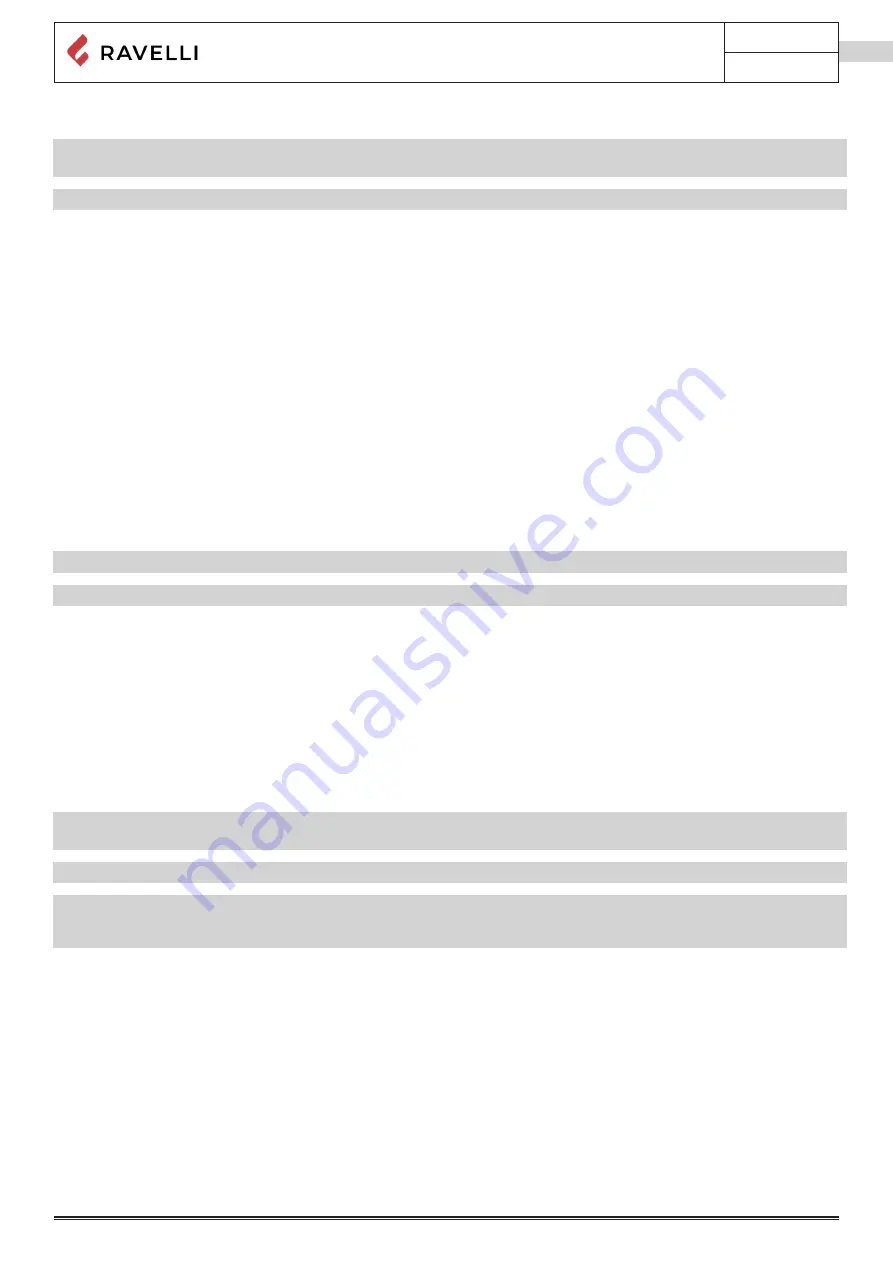
Use and maintenance manual Touch Radio Hydro
Pag.15
Rev.0 18/05/2021
EN
Set-ups for the smoke evacuation system
📌
Be careful when building the smoke evacuation system and observe the regulations in force in the country where the stove
is installed.
⚠
The Manufacturer will not be held liable for incorrectly sized and non-regulation smoke evacuation systems.
Smoke ducts and fittings
The term smoke duct indicates all ducts that connect the combustion equipment to the chimney.
The following requirements need to be applied:
•
observe product standard EN 1856-2;
•
the horizontal sections must have a minimum slope of 3% upwards;
•
the length of the horizontal section must be as minimum as possible, and its projection on the horizontal plane must not exceed
2 metres;
•
changes in direction must not have an angle of more than 90° (45° bends are recommended);
•
the number of direction changes, including the one necessary for insertion into the chimney, must not exceed 3;
•
the cross section must have a constant diameter, the same from where it exits the firebox up to the fitting into the chimney;
•
it is forbidden to use flexible metal and fibre cement pipes;
•
smoke ducts must not cross rooms where the installation of combustion equipment is prohibited.
In any case, the smoke ducts must be sealed against combustion products and condensation, as well as insulated if they lead outside
of the installation room.
Installing manual draught adjustment devices is not allowed.
Chimney
T
he chimney is a particularly important element for correct stove operation.
⚠
The chimney must be sized so as to guarantee the draught declared by the Manufacturer.
⚠
Do not connect the stove to a collective chimney.
The chimney must be built applying the following regulations:
•
it must observe product standard EN 1856-1;
•
it must be made of materials that are suitable to guarantee resistance against normal mechanical, chemical and thermal stress
and be correctly thermally insulated to limit the formation of condensation;
•
it must be mainly vertical and not feature any bottlenecks along its entire length;
•
it must be correctly spaced with an air gap and insulated from flammable materials;
•
there must be a maximum of 2 changes in direction and angles must not exceed 45°;
•
the chimney inside the home, however, must be insulated and can be inserted into a skylight shaft, as long as it respects
standards regarding placing inside a tube;
•
the smoke conduit must be connected to the chimney using a “T” fitting with an inspection collection chamber for combustion
residue and especially for collecting condensation.
📌
It is necessary to check the safety distances that need to be observed when there are flammable materials and the type of
insulating material that needs to be used is on the chimney data plate.
⚠
Use watertight pipes with silicone seals.
⚠
It is forbidden to use the discharge mounted directly on the wall or directed towards indoor spaces and any other type of
discharge that is not set forth by the regulation in force in the country of installation (Note: in Italy only roof-discharge is
allowed).
Chimney pot
The chimney pot, i.e. the top end of the chimney, must fulfil the following characteristics:
•
the cross-section of the smoke outlet must be at least twice the internal cross-section of the chimney;
•
it must stop water or snow from getting in;
•
make sure the smoke is taken away even when there is wind (wind resistant chimney pot);
•
the outlet height must be outside of the reflux zone (refer to national and local regulations to calculate the reflux zone);
•
it must always be built at a distance from antennas or dishes, it must never be used as support.
Summary of Contents for Hydro
Page 3: ......
Page 54: ......
Page 55: ......
Page 106: ......
Page 107: ......
Page 108: ......
Page 110: ...USE AND MAINTENANCE MANUAL HYDRO Handheld Touch Radio Hydro...
Page 111: ......
Page 162: ......
Page 163: ......
Page 164: ......
Page 166: ...BEDIENUNGS UND WARTUNGSHANDBUCH HYDRO PDA Touch Radio Hydro...
Page 167: ......
Page 218: ......
Page 219: ......
Page 220: ......
Page 222: ...MANUAL DE USO Y MANTENIMIENTO HYDRO Dispositivo Touch Radio Hydro...
Page 223: ......
Page 274: ......
Page 275: ......
Page 276: ......
Page 278: ...HANDLEIDING VOOR GEBRUIK EN ONDERHOUD HYDRO Handheld Touch Radio Hydro...
Page 279: ......
Page 330: ......
Page 331: ......
Page 332: ......
















































